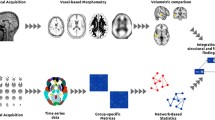Abstract
Objective As metabolic and structural changes in frontotemporal-subcortical pathways have been reported in patients with obsessive-compulsive disorders, we investigated the correlation between complex compulsive behaviour (CCB) and the distribution of atrophy in a group of 90 patients with frontotemporal dementia (FTD). Methods CCB was defined as complex, intentional, and time consuming repetitive behaviour, which was distinguished from simple compulsive behaviour (SCB), such as verbal and motor repetitions and utilisation behaviour. Cortical atrophy on CT and/or MRI was semi-quantitatively assessed in frontal, temporal, parietal and occipital regions, and the pattern of atrophy was compared between patients with and without CCB or SCB. Linear measures were used to establish the presence of caudate atrophy (bicaudate ratio) and ventricular enlargement (bifrontal ratio). Results CCB was reported in 18 (21 %) and SCB in 53 (61 %) FTD patients. Frontotemporal atrophy was present in 64 patients (74 %), and predominant temporal atrophy in 23 (26 %). The pattern of atrophy was asymmetric in 25 patients (29 %). Logistic regression analysis showed that temporal lobe atrophy (p < 0.005), as well as asymmetry of atrophy (p < 0.05) were independently associated with CCB, after adjusting for age at onset, gender, duration of symptoms at the time of imaging, severity of atrophy, and bicaudate and bifrontal ratio. No relationship was found between the presence of SCB and the distribution of atrophy, although patients with SCB tended to have more caudate atrophy (p < 0.1). Conclusion Temporal lobe atrophy appears to mediate CCB in patients with FTD, especially if asymmetry of atrophy is present. Future studies with quantitative and volumetric measurements of the cortical and subcortical structures may further clarify the aetiology of CCB in FTD.
Similar content being viewed by others
Author information
Authors and Affiliations
Additional information
Received: 29 November 2000, Received in revised form: 8 March 2001, Accepted: 25 March 2001
Rights and permissions
About this article
Cite this article
Rosso, S., Roks, G., Stevens, M. et al. Complex compulsive behaviour in the temporal variant of frontotemporal dementia. J Neurol 248, 965–970 (2001). https://doi.org/10.1007/s004150170049
Issue Date:
DOI: https://doi.org/10.1007/s004150170049




